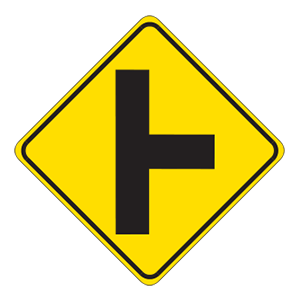2025 Louisiana Permit Test 12
The following questions are from real DMV written tests. These are some of the actual permit questions you will face in Louisiana. Each permit practice test question has three answer choices. Select one answer for each question and select "grade this section." You can find this button at the bottom of the drivers license quiz. For a complete list of questions and answers for Louisiana please visit https://cheat-sheets.dmv-written-test.com/en/louisiana/car.
Number of Tests
Number of Question
Passing Score
25. When backing up, you should:
Explanation
When backing up, turn your head over your shoulder and look through your rear window. Don’t rely only on your rearview mirror or backup camera.
26. This sign means:

Explanation
Warning signs prepare drivers for upcoming road conditions and hazards and are usually yellow with black markings. This sign tells drivers to be aware of potential traffic entering from an upcoming side road.
27. It is illegal for a person 21 years of age or older to drive with a minimum blood alcohol concentration (BAC) of:
Explanation
For drivers age 21 or older, it is illegal to operate a motor vehicle with a blood alcohol concentration (BAC) of 0.08 percent or higher. Driving while under the influence of alcohol is not only illegal, but dangerous.
28. When a curb is painted ____, it indicates a loading zone, or another parking restriction.
Explanation
Painted curbs indicate parking restrictions. When a curb is painted yellow, it indicates the presence of a loading zone, or another parking restriction.
29. Which of the following statements is true?
Explanation
When passing, you must always signal at least 100 feet in advance of your lane change. Always check behind you in your mirrors and look over your shoulder to check your blind spot. Wait until you can see both headlights of the passed car in your rearview mirror before returning to your original lane.
30. Your tire blows out while you are driving. You should:
Explanation
If you experience a tire blowout, do not immediately apply the brakes. Grip the steering wheel firmly and steer to remain in your traffic lane. Reduce your speed gradually by releasing the accelerator and staying off the brakes. Once you are moving very slowly, apply the brakes lightly and pull off the road into a safe area.
31. Defensive driving is:
Explanation
You drive defensively when you identify dangerous driving situations and take action before an accident occurs. Defensive driving helps prevent conflicts with aggressive, offensive, discourteous, careless, inattentive, impulsive, ignorant, or intoxicated drivers or pedestrians.
32. When you hear the siren or see the flashing lights of an approaching emergency vehicle, you must:
Explanation
